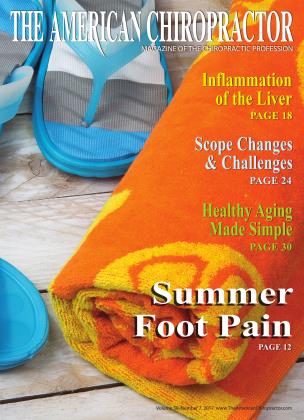Feet Don’t Have to Fear Summer
ORTHOTICS
Mark Charrette
Traditional warm weather footwear is notoriously problematic. Patients’ shoes can contribute either to health and whole-body wellness or to misery and musculoskeletal complaints.
Warm weather has arrived and sandals and flip-flops come with it. This time of year presents both challenges and opportunities for chiropractors. Patients’ shoes can contribute either to health and whole-body wellness or to misery and musculoskeletal complaints.
Improper footwear can lead to degenerative changes in the muscles, joints, and connective tissues in the feet. Gait, joint movement, circulation, and proprioceptive input could suffer when the body’s foundation is compromised.
Assess patients’ feet and shoes as part of your normal intake process, and don’t miss the opportunity to talk to them about proper footwear. Ideally, footwear should provide support, protection, and cushioning for the pedal foundation. If a patient’s shoes are poor in one or more of these categories, the spine will be exposed to abnormal stresses and continued usage could undo your hard work on the adjusting table.
Here’s a checklist to help your patients select healthy summer footwear.
1.Look for the shank.
A shank is a semirigid/semiflexible material that allows for
support and a normal or optimal range of motion when the foot is functional. The typical summer sandal is very thin and doesn’t allow for a shank, which usually results in an unstable pedal foundation.
2. Insist on three-arch support.
Optimal footwear will support all three arches: medial, lateral longitudinal, and anterior transverse. Accuracy can be measured from a weight-bearing cast or a functional scan. The height of the arches should be at the relative lowest end of the normal range of motion for that arch, which will allow for normal/optimal motion but block excessive motion, usually pronation.
3. Banish traditional flip-flops.
Of all the harmful summer footwear out there, traditional flip-flops are perhaps the most damaging. They’re notoriously flat, which offers little support or cushioning. Rates of heel pain—frequently due to plantar fasciitis—rise in the spring as flip-flop wearers shed their winter footwear. The problem worsens when the wearer is overweight or sedentary.1 Moreover, traditional flip-flops can alter gait, resulting in problems and pain throughout the kinetic chain.
Conclusion
Encourage your patients to choose their summer footwear carefully because it’s critical to good health. High-quality, supportive footwear gives the body a healthy, solid foundation that is less likely to experience biomechanical problems and is more receptive to chiropractic care.
Prescribing custom orthotics for every pair of shoes goes a long way to giving patients the support they need, or you could recommend orthotic footwear and sandals. This helps relieve your patients of the guesswork involved in selecting a healthy shoe, and it offers “two-for-one” benefits with built-in custom orthotics. Foot Levelers has a wide selection of Sandalthotics and custom orthotic flip-flops, which offer the fashion and comfort of regular flip-flops but in a healthier model.
Shoes that don’t properly support the feet can significantly interfere with chiropractic care. Whenever a patient presents with subluxations—especially those that do not correct rapidly and completely—I strongly recommend an examination of the patient’s feet and footwear.
References:
1. Shroyer JF, Weimar WH. Comparative analysis of human gait while wearing thong-style flip-flops versus sneakers. JAm Podiatr Med Assoc 2010;100(4):251-257.
graduate world-renowned Mark of N. Palmer Charrette College expert is in a extremity 1980 of Chiropractic. summa adjusting. cum He laude Over is a the past 20 years, Dr. Charrette has lectured extensively on spinal and extremity adjusting throughout the United States, Europe, the Far East, and Australia, performing more than 1,000 seminars. Dr Charrette is a featured speaker in Foot Levelers ’2010 Seminar Series.
 View Full Issue
View Full Issue






